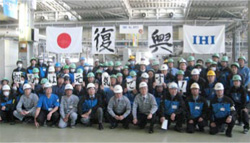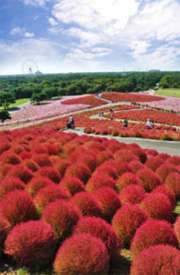Home > Highlighting JAPAN > Highlighting Japan SEPTEMBER 2011 > Wings for the World from the Disaster-stricken Area
Highlighting JAPAN
COVER STORY: A Rousing Summer in Tohoku
Wings for the World from the Disaster-stricken Area
As a result of the Great East Japan Earthquake, the manufacturing sector in the disaster-stricken area was greatly harmed. However, due to speedy recovery operations at the manufacturer level, production quickly returned to the pre-disaster status. The Japan Journal's Ames Pomeroy reports the example of IHI with its large-scale facilities in the city of Soma, Fukushima Prefecture.

IHI workers at Soma celebrate the full recovery of the plant in May. The banners spell out the word "recovery."
Credit: COURTESY OF IHI
A representative product output by its factory is a portion of the state-of-the-art jet engine GEnx, known as the turbine blade. The GEnx engine is well known for being used in the latest passenger aircraft Boeing 787. IHI has been participating in the joint development effort led by GE of the United States concerning this engine.
Turbine blade production was going smoothly in March when the Great East Japan Earthquake struck, violently shaking the factory structures. According to an IHI spokesperson, "the transformers broke down and the electrical power was shut down… moreover, many of the precision machines located within the factory were moved out of place, forcing us to halt operations." He added, "Nevertheless, the factory structures themselves sustained no major damage, and since we were fortunately not adjacent to the shoreline did not experience direct damage from the tsunami; even more important, all of our 1,500 employees were unharmed. Thus, we were able to immediately commence recovery of operations."
Recovery work started the day after the earthquake. Personnel from IHI factories all around the nation were brought in. In the beginning there were concerns about possible effects on aircraft production due to the work stoppage at the factory. However, as a result of concentrated efforts by workers to restart operations, a portion of the production line had already been fixed and work restarted as of the end of March, and by mid-May the facilities were once again fully operational.
IHI is also involved in rebuilding the region which suffered from the disasters, one example being the company's cooperation with the city of Soma to train those victims. Many people lost their jobs in the disaster-stricken areas, as a result for example of their workplaces having been swallowed up by the tsunami. On the other hand, there was a shortage of skilled personnel able to handle excavators, bulldozers and the like for removal of wreckage in these regions. IHI saw the need to ameliorate the situation and thus paid for all costs including transportation to send those distressed workers to an IHI training center located in the city of Ayase, Kanagawa Prefecture, so that they could obtain the license to operate heavy equipment such as cranes and excavators. As the IHI spokesperson noted, "Those people who had been displaced were able to obtain licenses to operate equipment that made work for them in joining with the rebuilding efforts."
Along with the aforementioned effort, the IHI group has contributed to relief funds for use by the devastated local governments in Fukushima Prefecture and Soma, in addition to helping secure water by providing emergency water processing equipment.

Summer cypress in fall at Hitachi Seaside Park. Dried branches and twigs from Summer cypress bushes were once used in Japan as materials to make brooms
Credit: COURTESY OF HITACHI SEASIDE PARK
Hitachi Seaside Park
Hitachi Seaside Park in Hitachinaka, Ibaraki Prefecture, is a large park extending over approximately 160 ha (see map page 7). Last year, the park attracted some 1.46 million visitors, who come to enjoy a variety of scenery and activities. In the sand dune area, for example, visitors can look down over the natural sand dunes to the vast Pacific Ocean below; the Pleasure Garden offers more than twenty-five different attractions, including a Ferris wheel affording a view from 100 meters above sea level; flowers can be viewed in abundance from the cycling course; and there are athletic facilities and a barbecue area too (reservations required).
One distinctive feature of the park is the opportunity to enjoy a variety of flowers all year round. Narcissus, tulips and nemophila in spring, zinnia and sunflowers in summer, summer cypress and cosmos in fall, and ice tulips in winter; these flowers can be enjoyed all over the park.
As a result of the Great East Japan Earthquake in March, cracks and uneven surfaces appeared in the roads, and facilities sustained damage, forcing the park to close for one month before it was able to reopen. The park assisted in the earthquake reconstruction effort by providing a domestic water supply to neighboring residents, donating cut Narcissus to schools that were unable to obtain flowers to display at their graduation ceremonies in March, and extending an invitation to the park to victims of the earthquake resident in the prefecture.
"A rock festival was held over three days in August, attended by 170,000 people," says a park official. "From around late September, approximately 30,000 summer cypress tree leaves will change color from green to red. In early and mid-October, the 3.5-ha hill will thus turn red with these summer cypress leaves and some 2 million dark red cosmos in full bloom. I hope you will come and see them for yourself."
© 2009 Cabinet Office, Government of Japan






